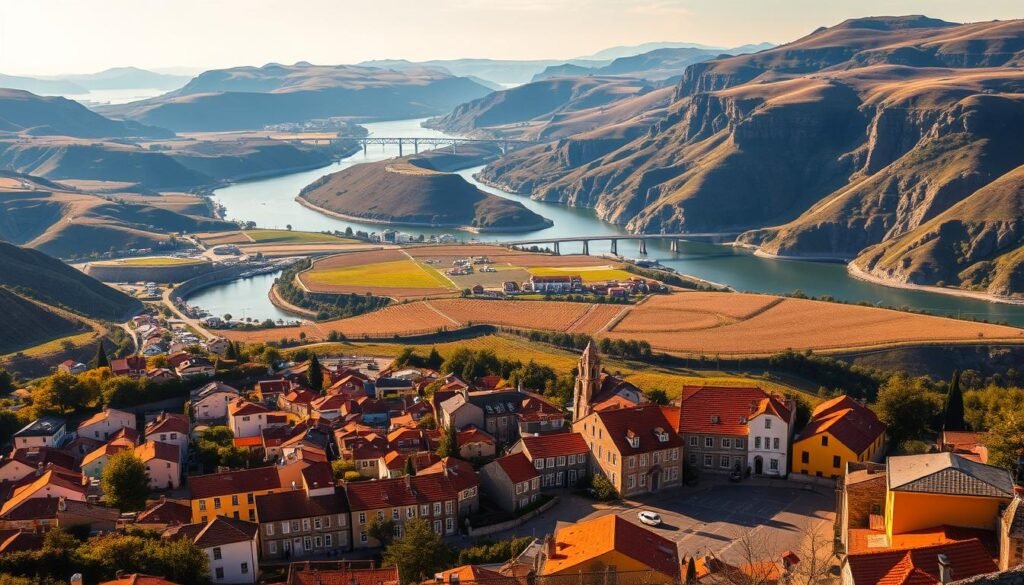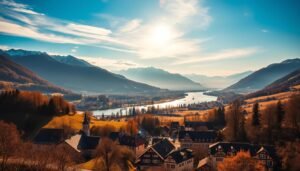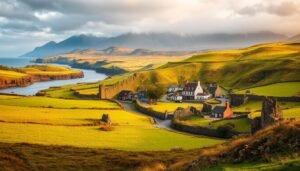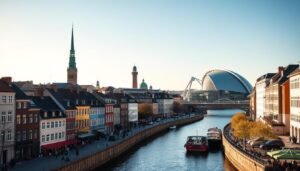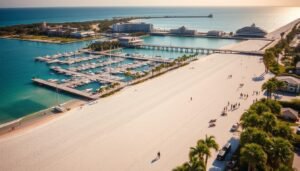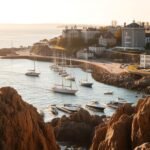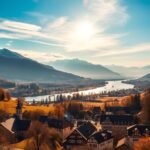Did you know that this small country draws more than 25 million visitors a year, yet you can still find quiet cliff trails and empty beaches within an hour of lively cities?
I planned my trip around a mix of sunlit Algarve shores, vineyard terraces in the Douro, and tram-lined streets of Lisbon. I wanted variety: lively cities, rugged cliffs, and calm wine regions.
Lisbon, the seven-hill capital, gave me tram rides, pastelarias, and castle views. Porto offered riverside charm, azulejos at São Bento, and port lodges across the river. Inland towns like Évora felt like time capsules.
This short guide shows how I balanced urban energy and quiet coastlines so you can shape your own highlights in fewer days without missing key sights.
Key Takeaways
- Combine Lisbon and Porto for city charm and history.
- Save time for the Douro if you love wine and river views.
- Mix beach days with inland cultural stops for variety.
- Traveling a compact country makes a packed trip easy to manage.
- Plan short stints in each region to enjoy both highlights and calm moments.
Why I Fell for Portugal: How I Picked These Destinations
![]()
I chose destinations that unfolded Portugal’s layers of past and present, from misty palaces to riverside warehouses.
I wanted a trip that showed real history and modern life. Lisbon gave me galleries like the Museu Nacional do Azulejo and Castelo de São Jorge, plus nightlife and lively streets. Porto offered the UNESCO Ribeira, port houses in Vila Nova de Gaia, and modern cultural hubs.
Évora’s Roman temple and narrow lanes revealed deeper time, while Sintra’s Pena Palace felt like a fairytale. Beyond the tourist core, Setúbal & Arrábida and Costa da Caparica offered wild coves I could reach in a single day.
- Practical pacing: I picked cities and towns with walkable streets and coastal spots reachable in a day.
- Local flavor: I favored regions with strong food, wine, and traditions.
- Flow: I planned where I’d linger overnight and where a quick stop would do.
I used this approach as a simple travel guide for other curious tourists who want variety without rushing.
The best places to visit in Portugal
![]()
My trip stitched together lively centers, misty palaces, and sunlit shores. I wanted a mix that showed both city energy and quiet landscapes.
Lisbon: capital streets and tram rides
I rode Tram 28 through cobbled neighborhoods, climbed to Miradouros, and felt the nightlife pulse on seven hills.
Porto: riverfront charm and port tastings
I walked the UNESCO-listed Ribeira, admired São Bento’s azulejos, and crossed bridges to Vila Nova for port tastings.
The Algarve region and Douro valley
Along the Algarve I found golden beaches, honeyed cliffs, and surf at Sagres. In the Douro Valley, terraced vineyards and boat cruises on the Douro River made for slow, taste-filled days.
| Destination | Highlight | Why I loved it |
|---|---|---|
| Sintra | Pena Palace | Misty gardens and UNESCO world heritage hills |
| Cascais | Boca do Inferno | Chic marina and dramatic coastal walks |
| Aveiro | Costa Nova | Moliceiro canals and striped beach houses |
| Óbidos | Walled center | Medieval castle walks with echoes of Roman times |
| Coimbra | University | Fado nights and riverside streets |
Coastal escapes I can’t stop recommending

Warm sea air and dramatic headlands drew me along Portugal’s southern and western coasts. I split days between famous bays and quieter shores so I could enjoy both the marquee scenery and empty stretches.
Praia da Marinha & Benagil Cave: Snorkeling, boat tours, and photo‑perfect cliffs
Praia da Marinha stole the show with golden cliffs, natural arches, and clear water made for snorkeling. I took a short boat tour into Benagil’s sunlit dome and swam near sea stacks beneath sheer cliffs.
Setúbal & Arrábida: Wild coves, azure waters, and Roman‑era echoes
Setúbal and the Arrábida region felt like a coastal secret close to the city. Fine-sand coves and calm turquoise inlets sit beside Roman-era ruins at Praia do Portinho da Arrábida.
Costa da Caparica: Easy day trip beaches south of Lisbon
Costa da Caparica made an effortless day trip from Lisbon. I hopped a quick ferry and found surf lessons, breezy beach bars, and long sandy walks along less crowded stretches further down the shore.
Western Alentejo: Vila Nova de Milfontes and wind‑sculpted shores
The western Alentejo gave me wide horizons and rougher scenery. Vila Nova de Milfontes was my pick for low-key evenings, wind-swept beaches, and roomy walks away from the Algarve buzz.
- I timed early swims at marquee beaches and late afternoons in quieter stretches to avoid crowds.
- I linked these stops by car and local buses, keeping logistics simple for a coastal leg of the country.
- After a beach day I liked strolling calm town streets and grabbing fresh snacks from small bakeries.
Inland heritage and wine country worth the detour
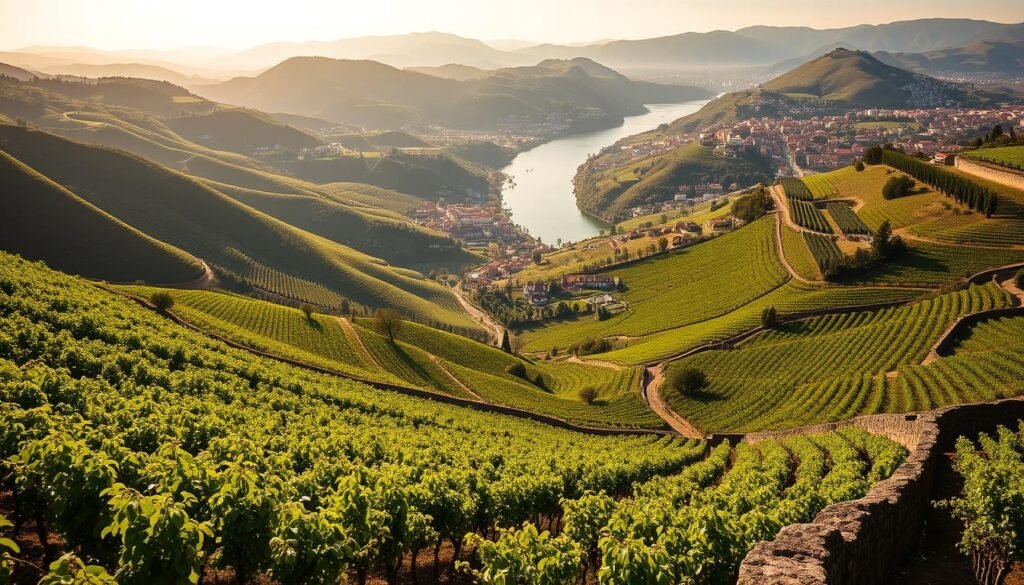
A few hours from the coast I found hilltop sanctuaries and river valleys that tasted like history and wine.
Braga anchors the Minho region with Roman ruins and a famed cathedral that tops its skyline. Nearby Guimarães wears its medieval center proudly; stout castles and narrow streets give a clear sense of the country’s early identity.
I split a day between the two towns—one in the morning, the other in the afternoon—and that rhythm let me soak in highlights without rushing.
Lamego, Peso da Régua & Pinhão: Quintas, tastings, and scenic train rides
The Douro Valley unfolds east of Porto along the douro river, where terraced vineyards define a UNESCO landscape and Europe’s oldest demarcated wine region.
I hopped between quintas for wine tastings, learning local port styles and table wines while watching boats drift below steep slopes. The scenic train into Pinhão gave relaxed vistas, then a short boat ride changed how I saw the valley’s contours.
Lamego added a savory note: a hilltop sanctuary and local specialties that paired perfectly with tastings in Peso da Régua. Choose a central town for the night and you’ll feel the region’s pace without overpacking your schedule.
“The valley moves at river speed—slow, rich, and surprisingly intimate.”
For suggested routes and practical timing, see a concise itinerary guide here: Douro and northern itineraries.
For hikers and mountain lovers

I found a different Portugal by hiking long ridges, crossing Roman paths, and sleeping in mountain towns.
Peneda‑Gerês (Minho): Wilderness trails, stone villages, and waterfalls
I felt Peneda‑Gerês as wild and authentic. Rugged peaks meet ancient Roman roads and time‑honored stone villages here.
Why it works: trails link waterfalls and cool river spots that make long days feel rewarding and relaxed.
Serra da Estrela: Alpine scenery, winter activities, and panoramic drives
Serra da Estrela has the highest peaks in mainland Portugal. It offers alpine scenery, skiing near Torre, and wide panoramic drives.
Snow can change conditions quickly, so I packed layers, checked trail apps, and planned short scenic drives around weather windows.
“Staying in small villages near trailheads cut my drive times and made early starts effortless.”
- I recommend trail combinations that give big views without technical difficulty, perfect if you’re new to the region.
- Bring waterproof layers, a trusted map app, and simple transport plans—local roads are narrow but charming.
- For route ideas and detailed maps, I used a compact guide to local hiking trails.
| Area | Highlights | Best season |
|---|---|---|
| Peneda‑Gerês | Waterfalls, Roman paths, stone villages | Spring–Summer |
| Serra da Estrela | Alpine trails, Torre skiing, panoramic drives | Winter–Autumn |
| Practical tips | Stay in nearby villages; use trail apps; pack layers | Year‑round (adjust for snow) |
My easy trip blueprints: days, routes, and must‑see highlights
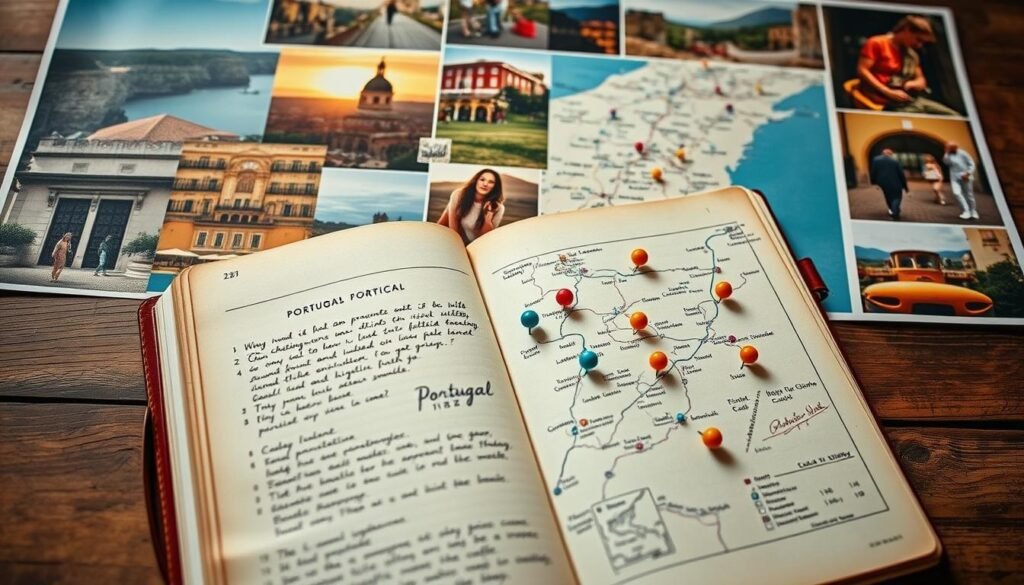
I sketched a compact route that balanced lively city streets with slow river valleys and palace gardens. This short plan is a practical guide for a weeklong trip that feels relaxed, not rushed.
Classic 7-10 days: Lisbon, Sintra, Porto, and the Douro Valley
I spent days splitting time between cities and countryside. I gave Lisbon two nights for tram rides and nightlife, one day for Sintra’s palaces, and two nights in Porto for the Ribeira and port lodges.
Then I carved out two days for the Douro Valley, fitting a scenic train ride and a short douro river cruise into one relaxed afternoon.
Best day trips: From Lisbon and from Porto
My favorite day trip options were Sintra for palace gardens, Cascais for coastal flavor, and Setúbal/Arrábida for quiet coves. From Porto I added Guimarães, Braga, or Aveiro for medieval streets and canals.
- Quick checklist guide: morning departures, afternoon check‑ins, evening strolls.
- Split long transfers into scenic legs so each move felt like part of the trip.
- Things I’d repeat: extra golden‑hour viewpoints and one more tasting in the valley.
When to go and how I plan my time
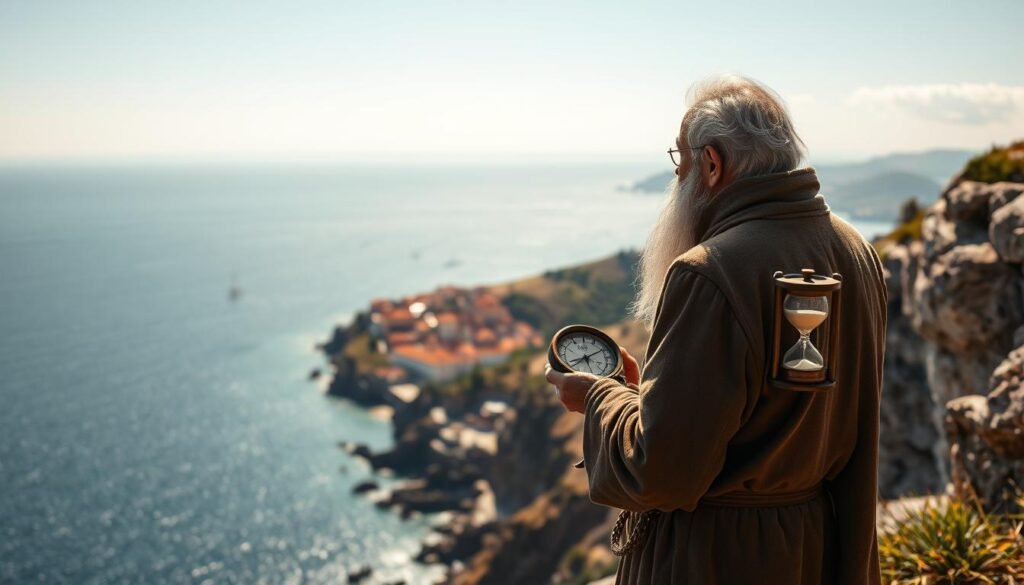
I learned quickly that a smart rhythm keeps crowded city mornings and calm coastal evenings from clashing.
Plan by season, not by map. I split long beach afternoons and cool mountain mornings so each destination felt at its best. The Algarve enjoys roughly 300 days of sunshine, which makes its beaches ideal for long summer days. Costa da Caparica and Arrábida sit close to Lisbon and work well for quick coastal escapes.
Sintra works year‑round with misty evenings, while Porto and the Douro make fine city and wine escapes outside peak months. Serra da Estrela shifts from summer hiking to winter skiing, so I packed layers and adjusted driving plans for snow.
Best time by region: beaches, cities, and mountains
- Shoulder seasons for cities: spring and fall give fewer tourists and milder weather.
- Long summers for beaches: Algarve and coastal spots are warm and reliable.
- Crisp months for mountains: Serra da Estrela is top for hiking in summer and snow sports in winter.
Travel tips: avoiding crowds, getting around, and making the most of your days
I beat Lisbon crowds by visiting major sights early and saving smaller museums and neighborhoods for midday. I mixed beach days with city nights to match sunlight and weather windows.
Transport choices I used: trains for Porto–Douro legs, car for remote coastlines and the Alentejo region, and occasional boats for caves and river cruises. I always left an easy recovery day after big museum or long walk days so the trip stayed fun, not frantic.
| Region | Best time | Why | Recommended transport |
|---|---|---|---|
| Algarve | Late spring–summer | Sunny weather, family‑friendly beaches | Car or regional bus |
| Lisbon & Coast | Shoulder seasons | Fewer tourists, easy day trips to Arrábida | Train, ferry, short car rides |
| Douro & Porto | Spring–fall | Wine season, pleasant city strolls | Train and boat |
| Serra da Estrela | Summer for hiking; winter for snow | Alpine scenery and seasonal activities | Car (mountain roads) |
“I built quiet windows into my plan so photo moments and peaceful walks felt earned.”
Conclusion
What stayed with me most was how small distances linked big contrasts: palaces, beaches, and wine terraces across a single, compact country.
I found world heritage layers at every turn — castles and palaces that feel alive, streets that whisper of roman times, and thoughtful cafés in lively city centers.
, the bridges of Porto, the port lodges in Vila Nova de Gaia, and the terraced amphitheaters along the Douro River remain clear highlights for me.
Sintra’s fantasy palaces, Évora and the Alentejo region for soulful inland days, and southern cliffs and beaches balanced the trip.
Pick the towns and villages that match your pace — nightlife, wine, seaside calm, or all three — and make the journey your own.


